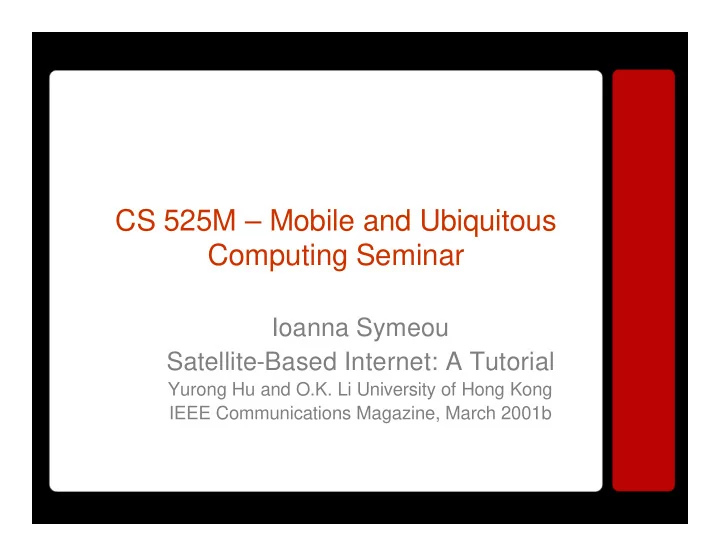

CS 525M – Mobile and Ubiquitous Computing Seminar Ioanna Symeou Satellite-Based Internet: A Tutorial Yurong Hu and O.K. Li University of Hong Kong IEEE Communications Magazine, March 2001b
Satellite-Based Internet: Introduction • Internet!!! • Why new technologies? – Growth (applications & hosts) – New QoS requirements – Mobility • Why satellite? – Global coverage – Broadcast capability – Bandwidth on demand flexibility – Mobility support • Satellite networks can be: Broadband access networks, high-speed backbone networks, communication links. • Challenges of interoperation of satellite systems and terrestrial Internet infrastructure
Satellite-Based Internet: Fundamentals • Satellite system: Gateway Stations (GS), Network Control Center (NCC), Operation Control Center (OCC) • Satellite types: – Geostationary Orbit (GSO): 35’786 km above equator synchronized with Earth’s rotation, covers 1/3 of Earth, RTD of 250-280ms – Medium Earth Orbit (MEO): 3’000 km above Earth, RTD of 110-130ms – Low Earth Orbit (LEO): 200 – 3’000km above Earth, RTD of 20-25ms – MEOs and LEOs require smaller antennas and less transmission power than GSOs but more satellites are needed to cover Earth.
Satellite-Based Internet: Fundamentals • Satellite Payload: – Simple and robust – Bent pipes: No onboard processing (OBP) – OBP payloads: Demodulation/redemodulation, decoding/recording etc – High-capacity intersatellite links (ISLs) • Frequency Bands: – C band (4-8GHz) – Ku band (10-18GHz) – Ka band (18-31GHz)
Satellite-Based Internet: Architectures •Many options due to various satellite systems, orbit and payload types. •Bent-pipe architecture – Low spectrum efficiency and long delay •Inter-satellite links – Routing issues
Satellite-Based Internet: Architectures • Two previous architectures used interactive terminals which are expensive in satellite systems. • Asymmetric architecture – Unidirectional routing
Satellite-Based Internet: Technical Challenges Multiple Access Control (MAC) • Long latency and limited power resource in satellites constrain choices of MAC protocol. • Protocol must be: simple, robust, support priorities, flexible, achieve high throughput, maintain channel stability, low overhead, small delays • Fixed assignment protocols: – Frequency division multiple access (FDMA) – Time division multiple access (TDMA): • Like FDMA, each station has dedicated channel, contention free, provide QoS • No interference (one user accesses transporter) – Code division multiple access (CDMA): • Code sequence assigned to users • Use of whole bandwidth (flexibility for system expansion)
Satellite-Based Internet: Technical Challenges Multiple Access Control (MAC) 2 • Random access protocols: – Due to increased number of users and bursty traffic fixed assignment replaced by random access – Random transmissions ignoring other stations – Collisions and retransmissions increase delays and decrease throughput • Demand assignment protocols: – Random access makes no QoS guarantees – Dynamically allocate bandwidth based on requests – Reservation can have centralized or distributed control, can made explicitly or implicitly – Some mechanisms: PODA, FODA (implicit and explicit reservations), CFDAMA, CRRMA, RRR (unreserved resources assigned to other stations after reservation)
Satellite-Based Internet: Routing Issues • Dynamic topology: – Two handover types (intersatellite, interbeam) – Two ISL types (intraplane, interplane may change) • Discrete-time Dynamic Virtual Topology Routing – Period time divided into time intervals – Topology remains the same within one interval – Routing tables retrieved when topology changes • Virtual Node Routing – Hide topology changes from protocols – VNs keep state info of users – VNs represented by different satellites as topology changes – Routing decisions based on virtual topology
Satellite-Based Internet: Routing Issues (2) • IP Routing – Based on VN routing – Variable –length packets, scalability of routing tables, computational & processing capacity limitations • ATM Switching – ATM version of DT-DVTR – All virtual channel connections between satellites grouped into a VPC – Onboard switching according to VPC labels
Satellite-Based Internet: Routing Issues (3) • External Routing Issues – Terrestrial Internet should not know details of satellite system: Satellite system is an AS – Space-based BGs: Too much computational load and storage requirements for satellites – Terrestrial BGs: Extra round trip delay but more realistic
Satellite-Based Internet: Routing Issues (4) • Unidirectional Routing – Static routing – Routing Modification • Send-only interface: feeder • Receive –only interface: receiver • Receivers filter update messages to identify potential feeders and vice versa – Tunneling • Virtual bidirectional tunnel set up between user and DBS • Packets are encapsulated/decapsulated at end- points
Satellite-Based Internet: Satellite Transport • TCP/IP and UDP/IP affected by delays and errors • TCP performance – Slow feedback, false timeouts and retransmissions – Very slow start! – TCP can’t differentiate between corrupted data and packet loss due to congestion – Network asymmetry affects ACK transmissions – Fairness issue • Performance Enhancements – TCP selective acknowledgment – TCP for transaction – Persistent TCP – Path maximum transfer unit – FEC
Satellite-Based Internet: Satellite Transport (2) • TCP extensions can’t solve problems like long end-to- end delays and asymmetry • Split TCP connections at the GSs – TCP spoofing • GS isolate divided connections and send spoofing ack’s – TCP splitting – Web caching • Web cache splits connection • Users connected to cache don’t need to set up TCP connections if required data are cached • Satellite Transport Protocol – NACK
Satellite-Based Internet: Conclusion • Possible architectures • Technical issues • Research issues: – IP QoS: • ATM based QoS • MPLS – Traffic and congestion control
Recommend
More recommend